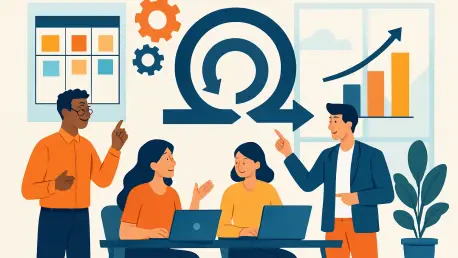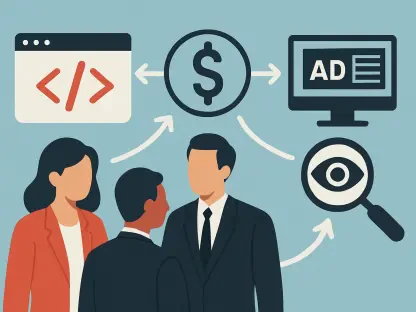In a fiercely competitive pharmaceutical landscape, where talent retention and operational efficiency can make or break an organization, a global leader in the industry recently embarked on a groundbreaking journey to modernize its Human Resources (HR) systems. Faced with outdated processes that frustrated employees and slowed innovation, the company recognized the urgent need for change to stay ahead. Traditional HR frameworks were proving to be a bottleneck, with manual tasks and rigid structures eating into valuable time that could be spent on strategic initiatives. This spurred a bold decision to adopt an Agile framework, a methodology known for its flexibility and focus on rapid, iterative progress. By partnering with experts in transformation, the organization aimed to streamline operations, boost employee satisfaction, and set a new standard for HR excellence in the sector. What unfolded was not just a technological upgrade, but a profound cultural shift that redefined how HR could drive business success.
Addressing Systemic Challenges in HR Operations
The initial spark for this transformation came from a stark realization that the existing HR systems were failing to meet modern demands, creating widespread dissatisfaction among employees across global offices. Cumbersome processes, repetitive manual tasks, and a lack of user-friendly tools meant that HR teams spent more time on administrative burdens than on engaging with the workforce or driving meaningful improvements. This inefficiency was not just a minor inconvenience; it was a significant barrier to attracting and retaining top talent in an industry where skilled professionals are in high demand. The complexity of the old systems also made it difficult to roll out updates or adapt to evolving employee needs, leaving the organization at a competitive disadvantage. Identifying these pain points was the first critical step, as it highlighted the urgent need for a complete overhaul of how HR services were designed and delivered, setting the stage for a radical rethinking of traditional approaches.
Beyond recognizing the problems, the company had to confront the daunting scope of transforming a global operation with diverse teams and varying needs. Resistance to change was a real concern, as long-standing practices were deeply ingrained in the organizational culture. Employees and HR staff alike were accustomed to linear, slow-moving development cycles that, while predictable, stifled innovation. The challenge was not only to introduce new technology but to shift mindsets toward a more dynamic, collaborative way of working. This required a carefully planned strategy to address skepticism and build trust in a new methodology that prioritized speed and adaptability over rigid planning. By focusing on the end goal of improved employee experience, the organization began to lay the groundwork for a solution that would tackle both operational inefficiencies and cultural barriers, ensuring that the transformation would be sustainable over the long term.
Embracing Agile for Faster, User-Centric Solutions
With the challenges clearly defined, the pivot to an Agile framework emerged as the most promising path forward, offering a stark contrast to the sluggish, top-down methods of the past. Agile’s emphasis on iterative development, where solutions are built and refined in short cycles, allowed for quicker feedback loops and adjustments based on real user input. This approach was particularly appealing in the context of HR, where employee needs can shift rapidly. By organizing teams into cross-functional units with clear priorities, the company ensured that every new feature or tool was designed with the end user in mind, rather than being dictated by inflexible corporate mandates. The adoption of six-week planning and review cycles further enabled incremental progress, ensuring that small wins built momentum and confidence in the process across the organization.
Another vital component of this shift was the focus on collaboration, both within internal teams and with external partners who brought specialized expertise to the table. Regular stakeholder engagement became a cornerstone of the Agile process, allowing for constant alignment on goals and swift resolution of any roadblocks. This collaborative spirit extended to suppliers as well, reducing lead times and ensuring that external dependencies did not derail progress. The result was a marked acceleration in the development and rollout of HR solutions, with new tools and services being launched at a pace previously unimaginable. Employees began to notice tangible improvements, from streamlined onboarding processes to more intuitive self-service platforms, which in turn boosted satisfaction and trust in HR’s ability to support their needs. This user-centric focus, underpinned by Agile principles, proved to be a game-changer in redefining the role of HR within the company.
Cultivating a Culture of Agility Through Training
Implementing an Agile framework was not solely about adopting new tools; it required a fundamental change in how teams operated and thought about their work. To achieve this, the company invested heavily in education and change management, rolling out a comprehensive coaching program tailored to the unique needs of HR product owners, project managers, and support staff. This initiative focused on equipping individuals with the skills to navigate iterative development, manage rapid testing cycles, and embrace a mindset of continuous improvement. By fostering internal champions who could lead by example, the organization ensured that Agile principles were not just a temporary experiment but a lasting shift in operational philosophy. This training was critical in breaking down silos and encouraging a more open, adaptive approach to problem-solving.
Equally important was the customization of support to address varying levels of readiness across global teams. Some groups were quick to adopt the new methodology, while others needed more hands-on guidance to overcome initial hesitations. Flexible coaching sessions and ongoing mentorship helped bridge these gaps, ensuring that no team was left behind in the transformation journey. The impact of this educational push was evident in the growing confidence of staff to tackle complex projects with speed and precision. As employees became more comfortable with Agile practices, they began to drive innovation from within, proposing ideas for new HR features that directly addressed pain points. This cultural evolution, supported by targeted learning, underscored that true transformation goes beyond technology—it hinges on empowering people to think and act differently in their daily roles.
Measuring Success and Sustaining Momentum
The outcomes of this ambitious overhaul were striking, with measurable improvements in both employee satisfaction and operational efficiency. Post-implementation surveys revealed a significant uptick in positive feedback about HR services, as regular updates and a user-focused design made interactions smoother and more effective. The ability to launch numerous new products globally in record time demonstrated the power of Agile to support a vast, diverse workforce. Coordination with internal teams and external suppliers also improved, slashing lead times and delivering greater value to the organization. Perhaps most notably, cost savings were realized in HR processes, freeing up resources for further innovation. These results positioned the company as a leader in leveraging Agile methodologies to transform complex, employee-facing functions.
Looking ahead, the focus shifted to sustaining this momentum by embedding Agile practices into the fabric of the organization for years to come. Plans were set to continue refining HR tools based on ongoing employee feedback, ensuring that systems remained flexible and responsive to changing needs. There was also a commitment to expanding training programs, equipping future leaders with the skills to maintain this culture of agility. Exploring how these principles could be applied to other business areas emerged as a potential next step, with the success in HR serving as a blueprint for broader transformation. By building on the foundation laid during this initiative, the organization aimed to stay ahead of industry trends and continue delivering exceptional value to its workforce. This forward-thinking approach ensured that the lessons learned would guide future efforts to innovate and adapt in an ever-evolving landscape.









